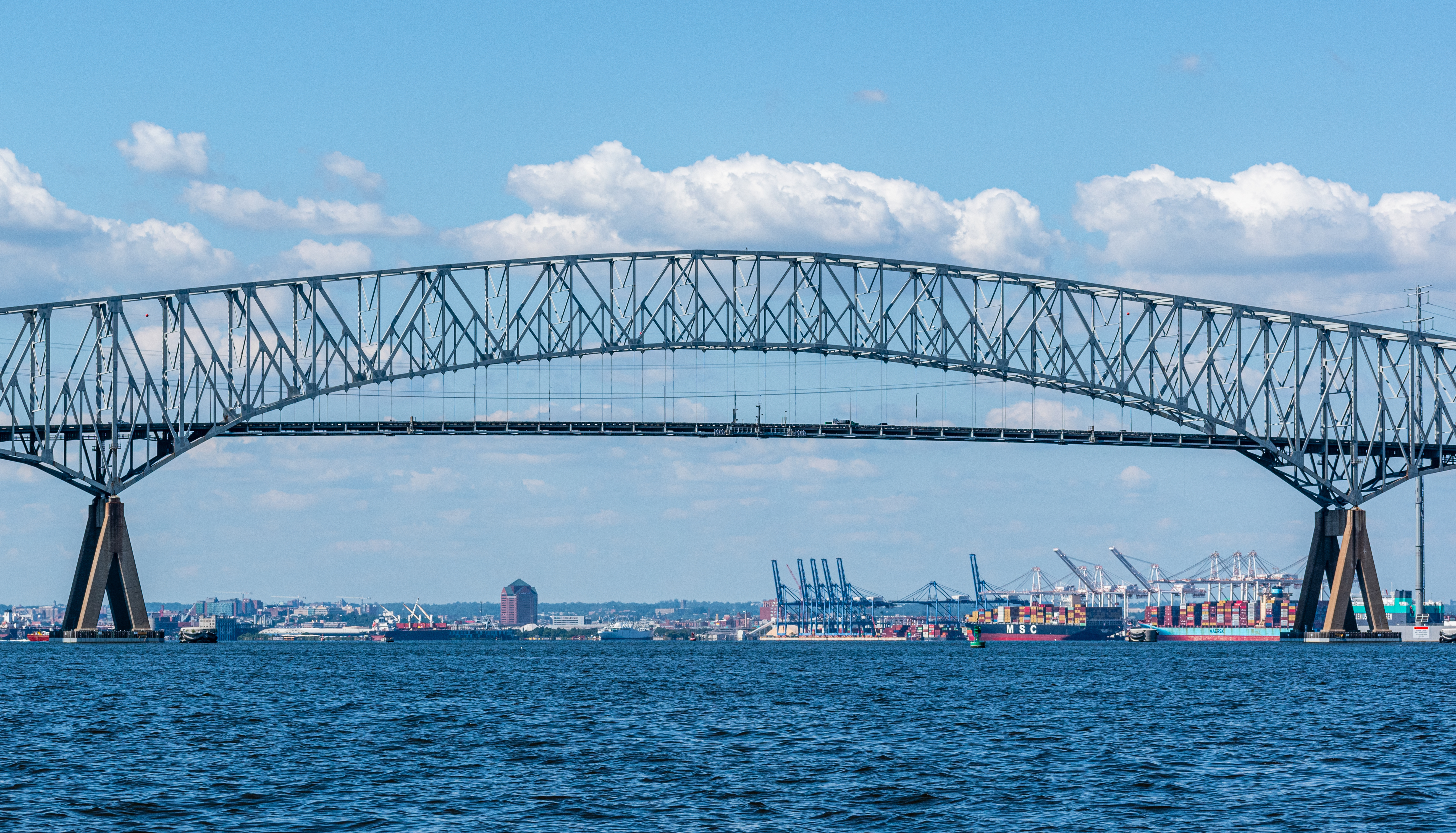Insuring the Unthinkable: Insurance Implications of the Francis Scott Key Bridge Disaster

By: John Rex Potts IV & Clark Parr
At 1:28 a.m. on March 26, 2024, cargo ship M/V Dali ran into the Francis Scott Key Bridge, causing the entire structure to collapse and killing at least six people. A bridge that stood for over 47 years crumbled into the Patapsco River in seconds, leaving the city of Baltimore devastated and certain supply chains disrupted. The insurance industry will feel the resulting implications for decades.
This article will provide an introductory discussion of the insurance implications of this event and how the industry examines catastrophic losses.
The Affected Parties
The global reach of the event will impact countless people and businesses. Expedited reconstruction of the bridge itself (originally construction over five years at a cost of ~$141 million) is likely to cost “several billion dollars.”1
The 4,900 containers on the ship will be evaluated for extraction, but it is possible that the cargo owners will not recover their goods. At least twenty-one vessels are stuck in the bay until debris can be removed and the passage is considered safe. Businesses and employees are losing income due to the inability to trade goods and/or travel without incurring additional costs. Additionally, the liability of the vessel’s owner or those involved in its recent maintenance must be determined.
The parties that we currently know are directly involved - Grace Ocean Pty Ltd that owns the M/V Dali, Maersk that chartered the vessel, Synergy Marine Group that manages the ship, the Port of Baltimore, and their respective insurance carriers.
Types of Insurance Coverage Triggered
In an incident of this magnitude, multiple lines of insurance come into play. Marine insurance, including Hull and Machinery Insurance, Protection and Indemnity (P&I) Insurance, and Cargo Insurance, will be crucial for the ship owners and operators. The City of Baltimore will rely on its property insurance, specifically bridge and infrastructure insurance. Liability insurance, such as general liability and employer's liability, will be essential for the parties found responsible for the accident. For the families of those lost and injured, life insurance and workers' compensation will provide some financial relief in their time of grief.
Potential Insurance Claims
The insurance claims arising from this incident will be numerous and complex. The damage to the M/V Dali will likely be covered by Hull and Machinery Insurance, while losses related to the ship's cargo will fall under Cargo Insurance. The City of Baltimore will file claims under its property insurance for the bridge's destruction and related infrastructure. Liability claims for the fatalities and injuries will be filed against the responsible parties, including the ship owners, operators, or even the city if bridge maintenance or design issues are discovered. Businesses impacted by the loss of the bridge may file business interruption claims to recoup their losses.
What remains to be seen is whether a General Average will be declared by the owners of the M/V Dali. General Average is a principle in maritime law that applies when a voluntary and intentional sacrifice is made to safeguard the vessel, crew, and cargo from a common peril. In such situations, all parties involved in the maritime venture (ship owner, cargo owners, and even the crew in some cases) proportionately share the costs associated with the losses incurred during the act of saving the ship and its cargo. The declaration of General Average would place an immediate lien on all cargo and the cargo owner will need to provide some sort of guarantee to get cargo released. This is a lengthy, costly process and cargo owners without insurance coverage are potentially exposed to a loss greater than the value of the cargo they shipped.
Determining Liability
Establishing liability in an accident of this scale will take months, if not years. Investigators will work diligently to uncover the cause of the accident, determine negligence and fault, and examine whether all safety regulations were followed. Early reports suggest that dirty fuel may have played a role in the ship's power outage, potentially implicating the fuel suppliers and handlers in the liability chain. The findings of the investigation will significantly influence how insurance claims are processed and settled.
What’s Next?
The long-term impact of this accident on the insurance industry cannot be overstated. Insurers may reassess the risks associated with cargo ships and bridges, potentially leading to increased premiums. Insurance policies and regulations may also evolve to address the lessons learned from this tragedy. The economic fallout for the city of Baltimore and the businesses relying on the bridge will be significant, with insurance playing a vital role in mitigating financial losses.
The potential for subrogation and insurance claims is seemingly endless. Ship owners, ship operators, bridge owners, and families of those injured or killed in the accident will look to insurance for assistance. The activity beyond the headlines will have implications for the insurance industry for decades to come. While this is a human tragedy, it is also a great example of why insurance for catastrophic events and limits exists. The depth of this event may drain the available insurance dry, leaving federal and local governments and those at the far-reaching ends of its effects to deal with the remaining costs.
Disclaimer: Swingle Collins & Associates has no relationship with any parties involved in the Baltimore bridge collapse incident and is not privy to any specific details about the insurance policies or claims related to this event. This article is provided for educational purposes only to illustrate the types of insurance considerations and implications that may arise from a catastrophic accident of this nature. The information provided is based on general insurance principles and should not be construed as legal, financial, or insurance advice.
Endnote
1 "New Bridge Bypasses the Baltimore Tunnel." New York Times, 27 Mar. 2024, https://www.nytimes.com/1977/03/27/archives/new-bridge-bypasses-the-baltimore-tunnel.html.
2"Chubb Leads Baltimore Bridge Property Cover but IG Subrogation Likely." Insurance Insider, 26 Mar. 2024, https://www.insuranceinsider.com/article/2d0uafwxptnitjeaqap6p/commercial-lines/chubb-leads-baltimore-bridge-property-cover-but-ig-subrogation-likely.



